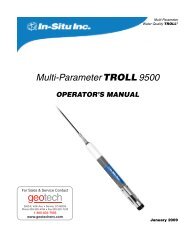TEST INSTRUCTIONS - Geotech Environmental Equipment
TEST INSTRUCTIONS - Geotech Environmental Equipment
TEST INSTRUCTIONS - Geotech Environmental Equipment
You also want an ePaper? Increase the reach of your titles
YUMPU automatically turns print PDFs into web optimized ePapers that Google loves.
Nitrogen is essential for plant growth, but the presence of excessive amounts in<br />
water supplies presents a major pollution problem. Nitrogen compounds may<br />
enter water as nitrates or be converted to nitrates from agricultural fertilizers,<br />
sewage, industrial and packing house wastes, drainage from livestock feeding<br />
areas, farm manures and legumes. Nitrates in large amounts can cause “blue<br />
babies” (methemoglobinemia) in infants less than six months of age. Nitrate<br />
concentration is an important factor to be considered in livestock products,<br />
where, in addition to causing methemoglobinemia, it is responsible for many<br />
other problems. Nitrates in conjunction with phosphate stimulate the growth<br />
of algae with all of the related difficulties associated with excessive algae<br />
growth.<br />
U.S. Public Health Service Drinking Water Standards state that 10 ppm<br />
nitrate nitrogen should not be exceeded. To the sanitary and industrial<br />
engineer, concentrations of less than 1 ppm are acceptable.<br />
APPLICATION: Drinking, surface, saline, domestic and industrial waters.<br />
RANGE: 0–25 mg/L Total Nitrogen<br />
METHOD: All forms of nitrogen are converted to nitrate by an alkaline<br />
persulfate digestion. Interference from halogen oxides is<br />
eliminated by the addition of sodium metabisulfite. Nitrate<br />
reacts in acid with chromotropic acid to form a yellow color<br />
SAMPLE<br />
HANDLING &<br />
PRESERVATION:<br />
in proportion to the amount of nitrate in the treated sample.<br />
If the sample can not be analyzed immediately, the sample<br />
should be preserved by adjusting the pH to 2 or less with<br />
concentrated sulfuric acid and refrigerated at 4C. Warm the<br />
sample to room temperature and neutralize with 5.0 N<br />
sodium hydroxide before analyzing.<br />
INTERFERENCES: Bromide (>60 ppm) and chloride (>1000 ppm) will have a<br />
positive interference.<br />
Nitrogen, Total 2/4 Smart2 <strong>TEST</strong> PROCEDURES 11.04

















